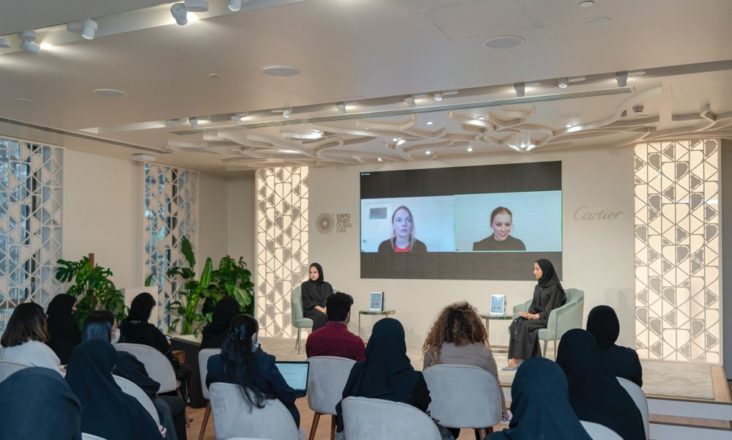Irthi Integrates Technology With Crafts In Newly Launched Digital Weaving Game At Expo 2020 Dubai

Irthi Contemporary Crafts Council (Irthi), an affiliate of the UAE-based NAMA Women Advancement Establishment (NAMA), launched Hiraf, an iPad game that serves as an educational tool to master the complex weaving techniques of two heritage crafts of the UAE, at a panel discussion hosted at the Women’s Pavilion at Expo 2020 Dubai.
‘Hiraf’, an Arabic word for ‘crafts’, was developed in collaboration with Netherlands-based Opera Amsterdam, Studio Louter and Studio Shosho, and is a fun and engaging way to learn the traditional Emirati weaving crafts of Talli and Safafah.
Led by a prominent panel of experts, the session titled ‘Crafting the Future’, explored how integrating technology with heritage crafts enhances its appeal amongst the tech-savvy younger generation, thus paving the way for sustaining and advancing traditional craft practices into the future.
The panel also focused on Irthi’ssustainable efforts in the preservation and promotion of local crafts and its extensive documentation ofthe Emirati Talli and Safafahweaving through collaborations with global designers and artisans, under the guidance and directives of Her Highness SheikhaJawaherbint Mohammed Al Qasimi, wife of His Highness the Ruler of Sharjah and Chairperson of NAMA.
By incorporating technology at every stage of the design and production process, Irthi has not only modernised and infused new life into the traditional crafts, but also ensured its sustainability through skills development of the younger generation of artisans, the panel revealed. The digital Hiraf game, especially appealed to the youth with its option of 3D printing designs in materials of their choice, opening new possibilities in design and techniques of crafts.
Irthi also facilitated a series of engaging Talli and Safafahdigital workshops at the venue, via the specially developed game loaded on iPads.
Prominent panelists at the session organised by Irthi Contemporary Crafts Council and moderated by Shahad Al Hammadi, Research and Documentation Senior Executive at Irthi included Denise Bax, Chief of Communication, Cities and Events Unit, and Director of the UCCN Secretariat; ElineKoning, Content Designer, Studio Louter; Anita Jansen, Programmer and Visual Storyteller, Studio Shosho; and Ghaya Bin Mesmar, Senior Executive, Design Projects, Irthi.
It was to reach out to a broader audience and educate and drive their awareness of the traditional crafts practices that Irthi decided to develop a tech-based game, explained Ghaya Bin Mesmar. “At Irthi, we believe that craft and technology are closely intertwined, and this hybrid brings a new level of interaction and experience. Through the Hiraf app, people can see a connection between technology and craft that may have not been obvious before.”
During the documentation process to help facilitate the development of the game, Irthi simplified the craft techniques and replaced the strands of khose and thread with leather for both the crafts. “In doing so, the process became less overwhelming, easier to understand and translate into a visual language. We also removed some traditional elements to develop a game that is as fun and exciting as it is visually appealing and graphically interesting.”
The tangible experience of the weaving game is manifested through the 3D printing option, in any material of choice. With Irthi having developed 25 designs of Safeefah and over 60 designs of Talli, the possibilities of widening the scope of the game are enormous. “This is just a start for us, we are still at the very beginning,” said Ghaya Bin Mesmar.
ElineKoningelaborated on the role of technology in keeping alive craft traditions and skills. She said: “Crafts are a way to connect with our past and is a vital part of our cultural Identity. Technology helps present crafts techniques in an engaging and playful manner that draws the modern generation and ensures transfer of knowledge of these traditional skills.”
She added: “We cannot make a digital app without knowing how the crafts work. The pioneering work done by Irthi in documenting the various techniques of Talli and Safeefahenabled us to seamlessly translate these into a digital format. Our main challenge was to bring about a balance in simplifying the techniques without diluting the complexity of the Emirati crafts traditions.”
Citing the importance of utilising technology to complement traditional crafts, Anita Jensen said, “The use of new media diffuses knowledge, enabling the younger generation to be more culturally aware of their heritage. Our goal when working on the Hiraf project was to embark on a responsible translation of the tangible experience of weaving into a visually appealing and enriching form.To achieve this, we broke the complex weaving and braiding processes into smaller steps and used swipe movements to enhance the user experience.”
Commending Irthi for its strides in empowering women artisans and elevating heritage crafts through contemporary adaptation of materials, design, and techniques, Denise Baxemphasised the potential of crafts in shaping a sustainable future. “Leveraging technology in crafts practices makes it both economically sustainable and appealing to a new generation of artisans. Artistic innovations generated by the fusion of tech with crafts enhances the value of heritage crafts and expands the scope of cross-sectoral collaborations.”
The synergies and opportunities that technology offers are yet to be explored, stated Bax, highlighting howIrthi’s virtual gallery that features 78 exclusive handmade luxury products has not only facilitated craftswomen to access new global markets but also enabled their social and economic empowerment.




